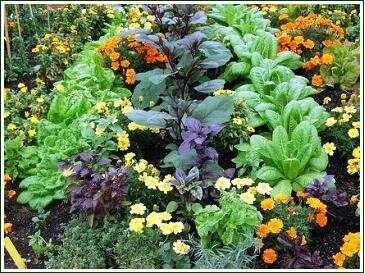Companion Planting . . .
Vegetable Gardening Plant Combinations
Companion planting and combining means growing plants together that like or benefit each other.

Vegetable companion gardening can have a real impact on the health and yield of your plants.
In nature everything interacts to create a whole life force. This is a basic understanding... that everything organic and living has a mutual influence on every other living thing.
Every plant has an effect on every other plant and every creature has an effect on every other creature.
Over time, gardeners have observed these interrelationships, and scientists have studied them.
It’s well worth while reading a little bit about how and why companion planting is so important before we get into which specific plants go with what. . . .
Plants, unlike many people, are not timid. They are always actively engaged in growing as fast and as strong as they can and re-populating their species. They do all this by sending out root hairs as far into the soil as they can depending on their surroundings.
They select and reject nutrients; they create in their structure and the environment, complex chemical compounds, such as perfumes, pollen, essential oils, growth inhibitors, hormones, enzymes and some minute trace elements.
Different species accumulate certain substances that affect the surrounding ecology, often once the plant has died and the decaying tissue is carried away and re-deposited by insect droppings, or other go-betweens.
Nature's Way of Companion Planting
The companion effect happens naturally in the wild. Flora and fauna of fields, meadows, forests, swamps and deserts, all evolve for mutual benefit. It may seem like survival of the fittest, but the truth is some species prefer to grow with specific others, balancing out their differences and providing ideal conditions for optimising their unique traits.
Plants don't like to fight for their food, so shallow rooted plants prefer to grow near deep rooted plants and each can get their nutrients from different levels. Some smaller plants like a bit of weather protection from bigger plants. Conversely, dry loving plants sulk if grown alongside plants that thrive with wet feet.
Just like us, life's too short for putting up with bad conditions... so aim for the good life for your plants too!
Uh oh... I hear you say...
If it all sounds overly complex and high falutin', step back and observe. That's what good gardeners are so good at... just observe what works for you in your patch, not what you read or what the Joneses do.
There's a good deal of debate on some of the mixes and matches of plant combining, and in one area or climate certain twosomes or threesomes may get along particularly well... but change the conditions... and trouble brews.
Often plants that seemingly dislike each other can successfully co-exist as long as they're spaced father enough away so their root zones don't overlap... therefore wider rows may work or maybe have some herbs planted amongst them.
If your garden is a jumbled jungle and thrives, then no need to order your plants around. But if perchance something isn't quite up to scratch, then practise a little plant companionship and see if that brings improvements.

Home veggie gardeners of course usually like to grow their food on as much available space as they can. They don’t want weeds, pests or ornamentals occupying valuable real estate!
But flowers for example make good companion plants as well as adding beauty. They can attract predators to go after pests and they bring bees to your garden for pollinating your fruit.
Aromatic weeds and herbs help confuse hungry pests that might go after your crops. Their fragrances can distract pests away or mask the odor from the pests’ normal favorite plants.

Intercropping or Interplanting goes hand in hand with companion planting. Read more here: Intercropping
Crop Rotation is also an indispensable ally for gardeners, and is another way of plants benefitting other plants. Read more here: Crop Rotation

The chart below lists the well-known basic veggie warm fuzzies... who loves who, who not, and why. For an excellent forum discussion, including a bit of argy-bargy, have a read of Spacing of plants when plant combining
Companion Planting Chart for Vegetables
|
Vegetable |
Good Companions
|
Bad Companions |
|
Asparagus |
Basil, tomato, nasturtium, parsley, basil, dill, coriander, marigold, aster flower |
Onion, garlic, potato, |
|
Beans |
Carrot, cabbage, cauliflower, cucumber, celery, corn, marigold. |
Chives, leek, garlic, onions, tomatoes, peppers |
|
Broad Beans |
Brassicas, carrot, celery, corn, lettuce, potato |
Fennel |
|
Beets |
Broccoli, lettuce, onion, sage |
Bean (pole and runner) |
|
Broccoli |
Celery, chamomile, mint, dill, rosemary |
Oregano, strawberry, tomato |
|
Brussels Sprouts |
Potato, thyme, dill |
Strawberry, tomato |
|
Cabbage |
Beetroot, bush beans, celery, mint, onion, potato, oregano, dill, chamomile, sage |
Strawberry, tomato |
|
Carrot |
Bush beans, pole beans, lettuce, onion, garlic etc, parsley, rosemary, pea, radish, tomato |
Dill, parsnip |
|
Cauliflower |
Peas, beans, celery, oregano |
Nasturtium, potato, strawberry, tomato |
|
Celery |
Cabbage, cauliflower, leek, onion, spinach, tomato |
Parsnip, potato |
|
Chard (Swiss chard, silverbeet) |
Cabbage, endive |
|
|
Corn |
Beans, cucumber, melon, peas, pumpkin, potato, radish |
Tomato |
|
Cucumber |
Beans, peas, celery, lettuce, pea, radish, nasturtium, corn |
Cauliflower, potato, basil and any strong aromatic herbs |
|
Eggplant |
Beans, capsicum, potato, spinach, peppers |
|
|
kohlrabi |
Onions, beets, lettuce |
Strawberries, tomatoes, pole beans |
|
Leek |
Carrot, celery, onions, strawberry |
|
|
Lettuce |
Carrots, radishes, strawberry, cucumber |
Beans, beetroot, parsley |
|
Melon |
Corn, radish |
Potato |
|
Onion |
Broccoli, cabbage, carrots, lettuce, strawberry tomato, beets, tomatoes, summer savory |
Beans, peas |
|
Pea |
Beans, carrot, corn, cucumber, radish, turnips, spinach, mint, potatoes |
Onion family |
|
Potato |
Horseradish, beans, corn, cabbage, pea, eggplant |
Cucumber, tomato, Jerusalem artichokes, pumpkin, squash, sunflower, raspberries |
|
Pumpkin |
Corn, beans, peas, radish |
Potato |
|
Radish |
Lettuce |
|
|
Spinach |
Strawberry, celery, cauliflower, eggplant, radish |
|
|
Tomato |
Asparagus, celery, NZ spinach, carrot, parsley, basil, marigold, garlic |
Corn, potato, kohlrabi, fennel, cabbage and other brassicas |
|
Turnip |
Peas |
|
|
Zucchini |
Nasturtium, flowering herbs |
|

